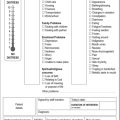21 Receiving treatment
Case update
• The size of the cancer was 2 cm in diameter.
• Two lymph nodes (glands) were positive under the arm.
• The grade of the cancer (how aggressive the cancer is) was assessed to be grade II (intermediate aggressive in appearance).
Postoperative care
Write a care plan for Michelle’s immediate postoperative care required.
http://www.nmc-uk.org/Documents/Guidance/nmcGuidanceRecordKeepingGuidanceforNursesandMidwives.pdf (accessed November 2011)
NMC Domain 1: 1.2; 1.3; 1.4; 1.5; 1.6; 1.9
NMC Domain 3: 3.1; 3.2; 3.3; 3.4; 3.5; 3.6; 3.7; 3.8; 3.9; 3.10
Points to consider
Points to consider
Points to consider
Cytotoxic therapy
What antiemetic is Michelle likely to be prescribed alongside this regimen?
What might the financial and social implications be of Michelle having to take time away from work?
NMC Domain 1: 1.2; 1.3; 1.4; 1.5; 1.6; 1.7; 1.8; 1.9
NMC Domain 2: 2.1; 2.2; 2.3; 2.4; 2.5; 2.6
Case update
Points to consider
• Observations: temperature, blood pressure, pulse, respirations, oxygen saturations, peripheral refill.
• Look at the patient’s skin colour, as well as the site of infection: wounds, CVAD sites, breaks in the skin or mucosa. The classic signs of infection – redness, warmth, pain, raised temperature – may or may not be present. Pus may not be present. This is because, if there is a lack of neutrophills, there will not be enough phagocytes to engulf the pathogen and produce the byproduct which is pus.
• Get a good history of the last few days: when cytotoxic treatment was last received; evidence of frequency or discomfort passing urine; persistent cough or cold; diarrhoea; pain, etc.
• Take blood for cultures (peripheral and from a CVAD if in place), full blood count and biochemistry, as well as specimens and swabs of any area of the body that may be the likely site of infection (urinalysis; mid-stream urine specimen; swab CVAD sites; sputum specimen if cough present; stool specimen if diarrhoea; throat swab if sore).
Points to consider
Radiotherapy toxicities
Find out what the local radiotherapy skin care protocols are in your area.
Find out what strategies help with cancer-related and cancer treatment-related fatigue.
Why might Michelle feel anxious coming to the end of treatment?
NMC Domain 1: 1.2; 1.3; 1.4; 1.5
NMC Domain 2: 2.1; 2.2; 2.3; 2.4; 2.6
Points to consider
The next three chapters explore two very different possible paths Michelle’s story may take. Chapters 22 and 23 explore the situation where Michelle presents with secondary disease and her prognosis is poor. Chapter 23 offers an alternative ending, in which Michelle remains disease free and lives a healthy life beyond cancer. Statistically, this is the most likely outcome, reflecting the 82% of all women diagnosed with breast cancer who survive 5 years and 73% of women who survive 10 years (Rachet et al 2009).
Cooley C. Cancer survivorship, part 1: how services need to change for those living with and beyond cancer. Nurs. Times. 2010;106(20):24–25.
Cox K., Wilson E. Follow-up for people with cancer: nurse led services and telephone interventions. J. Adv. Nurs.. 2003;43(1):51–61.
Office for National Statistics. Survival rates in England, patients diagnosed 2001–2006. London: ONS; 2007.
Pennery E. The role of endocrine therapies in reducing risk of recurrence in postmenopausal women with hormone receptor-positive breast cancer. Eur. J. Oncol. Nurs.. 2008;12(3):233–243.


